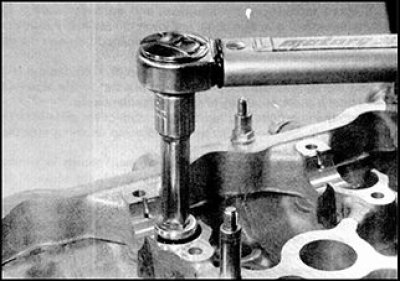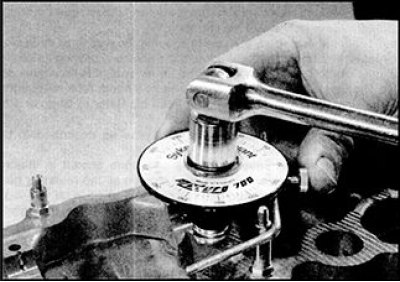Attention! To facilitate assembly, mark the brackets to be removed and mark the routing of wires and hoses.
Removing
1. Drain the coolant.
2. Remove camshafts (see subsection 3.2.1.9).
3. Please note that the following description refers to the removal of the head assembly with exhaust and intake manifolds. At the same time, the amount of work to remove the head is reduced, but manipulation with the head is difficult due to the increased size and weight of the entire assembly. It is recommended to remove both manifolds first (see subsection 6.1.12 and subsection 6.1.13).
4. On engines with preliminary preparation of the fuel-air mixture (single channel injection system) do the following:
- remove the air filter;
- perform measures to decompress the fuel system and disconnect the fuel supply hose and return hose from the throttle valve chamber (plug all openings to prevent fuel loss and dirt from entering the fuel system);
- disconnect the throttle cable;
- disconnect the wiring connectors from the throttle chamber, intake manifold and other parts;
- disconnect the hoses of the vacuum brake booster, cooling system and crankcase ventilation system from the corresponding valves and pipes mounted on the cylinder head;
- remove the suction manifold support bracket;
- Disconnect the exhaust pipe from the exhaust manifold.
5. On engines with direct fuel injection (with multichannel injection system) do the following:
- remove the air filter and air duct;
- perform measures to decompress the fuel system and disconnect the fuel supply hose and return hose from the fuel distributor (plug all openings to prevent fuel loss and dirt from entering the fuel system);
- disconnect the throttle cable;
- disconnect the wiring connectors from the throttle chamber, intake manifold and other parts. Disconnect the wiring from the injectors and take it aside so that it does not interfere with the removal of the cylinder head;
- disconnect the hoses of the vacuum brake booster, cooling system and crankcase ventilation system from the corresponding valves and pipes mounted on the cylinder head;
- remove the support bracket (s) suction manifold;
- Disconnect the exhaust pipe from the exhaust manifold.
6. On vehicles equipped with automatic transmission, disconnect the downshift cable from the throttle chamber.
7. Loosen the clamps and disconnect the hoses from the coolant pump, from the heater radiator and from the oil cooler (if provided). Disconnect also hoses of a radiator of system of cooling in a forward part of a head of cylinders.
8. On Phase I direct injection engines, remove the starter (see subsection 7.6) then loosen and remove the bolt securing the coolant pipes to the rear of the cylinder block.
9. Disconnect the wiring connectors from the ignition distributor, from the ignition coil and from the transistor power supply. Disconnect the wiring sleeve from the clamps, take it away from the cylinder head. Turn away bolts and remove all wires on weight, fixed on a head of cylinders and on a soaking-up manifold.
10. Release bolts of fastening of an arm of the generator to a head of cylinders.

11. Loosen and unscrew the M6 bolts securing the cylinder head to the timing chain cover (if these bolts are not already loosened), also remove the bolt at the front of the cylinder head.

12. Working in the reverse order of the diagram, loosen all ten main cylinder head bolts. Loosen the bolts in several steps, 1/2 turn per step, until the bolts can be turned away by hand.
13. Remove the bolts and washers, paying attention to their position in the cylinder head.
14. Remove the cylinder head. It is advisable to perform this operation with an assistant, since the head assembly with camshafts is quite heavy (especially if the collectors are not removed). Remove the gasket from the cylinder block, paying attention to the two dowel pins. If the pins come out of the holes, then remove them, remembering the position of the initial installation, and store with the cylinder head. Also pay attention to the correct installation of oil nozzles in the cylinder block. If the injectors are loose and can be removed, remove them and store with the cylinder head.
15. Check for damage on the split surfaces of the cylinder head and block (deep scratches, chips, etc.). Minor damage is removed with a needle file, serious damage is removed only by grinding.
16. If the head will be disassembled for overhaul, then follow the description in the appropriate subsection.
Assembly preparation
1. The manufacturer recommends that the cylinder head bolts be measured to determine their suitability. Measure the length of each bolt (removing the washers) from the inner surface of the bolt head to the end of the threaded part. If the length of all bolts is less than 158.2 mm, then the bolts can be used. If the length of at least one of the bolts exceeds 158.2 mm, then all the bolts in the kit should be replaced. Given the stress that the cylinder head bolts experience, it is strongly recommended that they be replaced regardless of condition.
2. Before installing the cylinder head on the engine, thoroughly clean the split surfaces of the head and block. Remove carbon deposits and gasket material with a hard plastic or wooden spatula, also clean the piston crowns from carbon deposits. Take extra care when cleaning as the surfaces can be easily damaged. Also take measures to prevent the ingress of carbon deposits removed into the oil channels or channels of the cooling system in the cylinder block, otherwise the channels may be blocked and the lubrication of engine parts may be impaired. Cover the oil passages, cooling system passages and bolt holes in the cylinder block with adhesive tape and paper. To prevent dirt from entering the gap between the piston and cylinder, coat the gap with grease along the edge of the piston crown. After cleaning the pistons, brush off the grease from the gap and wipe off any remaining grease with a clean rag.
3. Check for damage on the split surfaces of the cylinder head and block (deep scratches, chips, etc.). Minor damage is removed with a needle file, serious damage is removed only by grinding.
4. If there is suspicion of deformation of the split surfaces, then check the deviation of these surfaces from the plane using a gauge.
Installation
1. Wipe dry the split surfaces of the head and cylinder block. Replace the two dowel pins (if filmed) and insert the oil jets into the cylinder block.
2. Place a new gasket on the cylinder block, aligning the holes in the gasket with the pins.
3. With an assistant, carefully install the head onto the cylinder block, aligning the head with the dowel pins.

4. Lubricate threads and undersides of bolt heads with clean oil. Put washers on the bolts and carefully insert the bolts into the corresponding holes in the cylinder head (dropping bolts into holes is not allowed). Wrap bolts and tighten by hand.
 |  |
5. Tighten the main 10 cylinder head bolts in the sequence shown, with the torque corresponding to the 1st stage of tightening. Tighten with a socket head torque wrench.
6. After completing the 1st stage of tightening, tighten the bolts with the torque of the 2nd stage.
7. Wait a minute and loosen the bolts in the reverse order shown in the bolt tightening diagram in step 5. Loosen the tightening gradually, 1/2 turn at a time, until the bolts begin to turn away by hand.
8. Finger-tighten the 10 bolts again, then tighten in sequence to 3rd stage torque.

9. After performing the 3rd stage, tighten the bolts to the angle specified for the 4th stage of tightening. Tightening at this stage is recommended to be done with an angle scale wrench to ensure that the tightening requirements are met exactly. If an angle wrench is not available, paint marks on the head of the bolt and on the surface of the cylinder head. The marks must be at the specified angle. These marks should be guided when performing the 4th stage of tightening.
10. After completing the 4th stage of tightening the main cylinder head bolts, tighten the bolts to the torque of the 5th stage in the sequence shown.
11. After the final tightening of the main cylinder head bolts, screw the M6 bolts in the front of the cylinder head and tighten them to the specified torque.
12. Lay the wiring along the previous route, connect the wiring connectors to the ignition distributor, to the ignition coil and to the transistor power supply. Secure the wiring in place with tie-downs and clamps.
13. Connect the ground wires to the cylinder head and manifold, tighten the bolts securely.
14. On Phase I direct injection engines, install the cooling pipe bolt into the cylinder block and tighten securely. Install starter (see subsection 7.6).
15. Attach the cooling system hoses, observing the original order of their installation, secure the hoses with clamps.
16. Based on the relevant Part in Chapter 4, do the following:
- connect all wiring, hoses and control cables to the parts of the fuel system and to the intake manifold;
- install the suction manifold support bracket;
- attach the muffler downpipe to the exhaust manifold;
- install the air filter and air duct (if provided).
17. On vehicles equipped with automatic transmission, connect and adjust the downshift cable.
18. Install camshafts (see subsection 3.2.1.9).